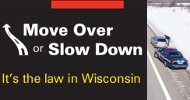2/8/2010
Wisconsin Appeals Court Limits Scope of Move Over LawDriving into head-on traffic is not required by the Move Over statute in Wisconsin, according to the state court of appeals.

When approaching a police car parked on the side of the road, a motorist does not need to change lanes into oncoming traffic to escape punishment under one state's "move over" law. The Wisconsin Court of Appeals on Thursday disagreed with state officials who had insisted that failure to make such a maneuver should result in a traffic ticket.
At around midnight on April 5, 2008, Portage County Sheriff's Deputy Robert Wanta parked his squad car, emergency lights activated, on the side of Highway 10, a two-lane road, so that he could issue a traffic ticket. After Wanta finished the transaction, he noted that two cars were approaching his location. The second car pulled into the lane for oncoming traffic away from his police car, but the first did not. Wanta saw the opportunity to issue another ticket and chased after and stopped the lead vehicle driven by David G. Baake.
"Generally when I return to my squad car I can get an idea if somebody is going to slow down or if I get a little concerned that they're coming at my squad car," Wanta explained in his court testimony. "I became concerned because this vehicle was continuing in its normal lane of travel, close enough that I did not feel comfortable returning to my squad car because I was not sure if the car would be rear-ended or if I might be hit if I tried to return to my car."
Prosecutors argued that because Highway 10 is marked with a divided yellow line signifying that passing is permitted, the motorist must "change lanes," if possible, to avoid a citation. The road, in effect, allows two lanes of travel in the same direction. The appeals court found this interpretation unacceptable.
"By its plain language, [the statute] only requires a motorist to change lanes if there are two or more lanes in the motorist's direction of travel and it is safe to do so," Presiding Judge Charles P. Dykman wrote.
The court pointed out that the law explicitly provides for an alternative of slowing down for two-lane roads like Highway 10.
"The statute simply does not require a motorist on a roadway with only one lane of travel in the motorist's direction to move into the lane for oncoming traffic when passing a stopped motor vehicle," Judge Dykman wrote. "Wanta testified that he was 'concerned' about Baake's driving because Baake continued in the same lane of travel as Wanta's vehicle, which we have concluded is not prohibited by statute. Wanta did not provide any testimony that Baake failed to slow down or that he was traveling at an unsafe speed, or any other details that would support reasonable suspicion of a traffic violation... We therefore conclude that there was no reasonable suspicion to support the stop."
Because the traffic stop was invalid, Baake's arrest for driving under the influence of alcohol will be thrown out. A copy of the decision is available in a 40k PDF file at the source link below.
Article Excerpt:
Wisconsin Move Over Law, 346.072Source:
(1) If an authorized emergency vehicle giving visual signal … is parked or standing on or within 12 feet of a roadway, the operator of a motor vehicle approaching such vehicle or machinery shall proceed with due regard for all other traffic and shall do either of the following:
(a) Move the motor vehicle into a lane that is not the lane nearest the parked or standing vehicle or machinery and continue traveling in that lane until safely clear of the vehicle or machinery. This paragraph applies only if the roadway has at least two lanes for traffic proceeding in the direction of the approaching motor vehicle and if the approaching motor vehicle may change lanes safely and without interfering with any vehicular traffic.
(b) Slow the motor vehicle, maintaining a safe speed for traffic conditions, and operate the motor vehicle at a reduced speed until completely past the vehicle or machinery. This paragraph applies only if the roadway has only one lane for traffic proceeding in the direction of the approaching motor vehicle or if the approaching motor vehicle may not change lanes safely and without interfering with any vehicular traffic.
Permanent Link for this item
Return to Front Page


